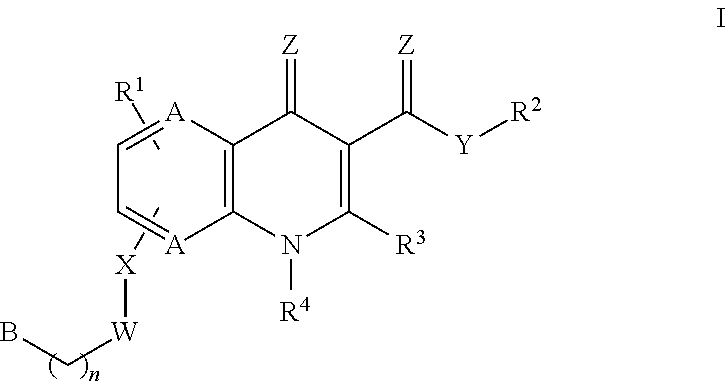Monocarboxylate transport modulators and uses thereof
a technology of monocarboxylate and transport modulator, which is applied in the field of compounds, can solve the problems of relapse, patient mortality, and increased risk of cancer invasion and metastasis by hypooxia, and achieves the effects of reducing the risk of cancer invasion and metastasis, and improving the safety of patients
- Summary
- Abstract
- Description
- Claims
- Application Information
AI Technical Summary
Benefits of technology
Problems solved by technology
Method used
Image
Examples
example 1
[0313]
Step 1
[0314]
Procedure
[0315]In a 250 mL, 3-neck round-bottomed flask, 3-Chloro-4-fluoroaniline (20 g, 137.4 mmol) was added with toluene (100 mL). To this reaction mixture, diethyl-2-(ethoxymethylene) malonate (29.7 g, 137.4 mmol) was added at 25° C. The reaction mixture was heated at reflux under stirring for 1 h, then cooled to 30° C. and added water (150 mL). The mixture was extracted with EtOAc (30 mL×3). The combined organic layer was washed with brine solution, dried over anhydrous Na2SO4 and concentrated under reduced pressure to obtain 40 g of crude product which was triturated with minimum hexanes to obtain diethyl-2-((3-chloro-4-fluorophenylamino) methylene)malonate (1) 36 g; Yield (50.1%); 1H NMR (400 MHz, DMSO-d6): δ 10.61 (d, J=12.8, 1H), 8.29 (d, J=13.6, 1H), 7.72-7.74 (m, 1H), 7.4-7.42 (m, 2H), 4.12-4.2 (m, 4H), 1.24-1.26 (m, 6H); MS (ESI): 316.1(M+H).
Step 2
[0316]
Procedure
[0317]In a 500 mL, 3-neck round-bottomed flask, diphenylether (200 mL) was heated up to 150°...
example 2
[0325]Mother liquor remained from the synthesis of Example 1 was concentrated under reduced pressure to obtain the crude 5b. The product was purified by column chromatography (silica gel) to obtain 10 mg of pure 6-(benzyl(methyl)amino)-7-chloro-1-isobutyl-4-oxo-1,4-dihydroquinoline-3-carboxylic acid (5b): Yield, 5%; 1H NMR (400 MHz, DMSO-d6): δ 15.16 (d, 1H), 8.95 (s,1H), 7.28-8.27 (m, 7H), 4.41-4.43 (d, 2H), 4.3 (s, 2H), 2.74 (s, 3H), 2.1-2.2 (m, 1H), 0.88-0.90 (d, 6H); MS (ESI): 399(M+H); HPLC: 93.57%.
example 3
[0326]
Procedure
[0327]In a 25 mL single neck round-bottomed flask, the intermediate 4 (0.5 g, 1.679 mmol) from Example 1 and N-methyl-1-(3-(trifluoromethyl)phenyl)methanamine (1.5 g, 8.39 mmol) were added and heated to 120° C. for 24 h. The reaction was monitored by TLC for completion followed by an aqueous worked up and acidified with 1N HCl to pH 3-4. The aqueous layer was extracted with EtOAc and the organic layer was dried over anhydrous Na2SO4. The solvent was evaporated under reduced pressure to obtain the crude product which was purified by silica gel column chromatography to provide pure 6-fluoro-1-isobutyl-7-(methyl(3-(trifluoromethyl)benzyl)amino)-4-oxo-1,4-dihydroquinoline-3-carboxylic acid (5), (25 mg); Yield; 3.3%; 1H NMR (400 MHz, DMSO-d6): δ 15.5 (s, 1H), 6.83-8.71 (m, 7H), 4.75 (s, 2H), 4.20 (d, 2H), 3.13 (s, 3H), 1.83-1.86 (m, 1H), 0.74-0.76 (d, 6H); MS(ESI): 451.1(M+H); HPLC: 92.07%.
PUM
| Property | Measurement | Unit |
|---|---|---|
| temperature | aaaaa | aaaaa |
| temperature | aaaaa | aaaaa |
| temperature | aaaaa | aaaaa |
Abstract
Description
Claims
Application Information
 Login to View More
Login to View More - R&D
- Intellectual Property
- Life Sciences
- Materials
- Tech Scout
- Unparalleled Data Quality
- Higher Quality Content
- 60% Fewer Hallucinations
Browse by: Latest US Patents, China's latest patents, Technical Efficacy Thesaurus, Application Domain, Technology Topic, Popular Technical Reports.
© 2025 PatSnap. All rights reserved.Legal|Privacy policy|Modern Slavery Act Transparency Statement|Sitemap|About US| Contact US: help@patsnap.com



